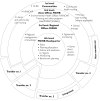Why equity in financing first nations on-reserve health services matters: findings from the 2005 national evaluation of the health transfer policy
- PMID: 19305735
- PMCID: PMC2585472
Why equity in financing first nations on-reserve health services matters: findings from the 2005 national evaluation of the health transfer policy
Abstract
Background: This paper reports on selected findings from the 2005 National Evaluation of the Health Transfer Policy. Three hypotheses were tested, namely: (1) that inequalities in per capita financing exist between First Nations organizations, (2) that variations in per capita funding among communities cannot be explained by variations in the program responsibilities each assumed and (3) that First Nations organizations that transferred in the early 1990s now have access to fewer resources on a per capita basis than those that transferred more recently.
Methods: We compared (1) the per capita funding for 30 medium-sized communities (population = 401-3,000) that have Health Centres and the 13 similarly sized communities that have Health Stations, (2) program responsibilities and per capita funding for the same 30 communities and (3) the relationship between 2001-2002 per capita funding and the year of transfer for the same communities. We used data provided to us by the First Nations and Inuit Health Branch of Health Canada from 1989 to 2002.
Results: The results show that differences in per capita funding exist among and within regions. These differences cannot be explained by the responsibilities each community chose to assume. Differences are also related to the year First Nations entered into a transfer agreement.
Conclusions: We recommend that formula-based financing be adopted to reduce inequalities. Such a formula should reflect needs, population growth and changes in costs of service delivery.
Contexte :: Cet article présente des résultats sélectionnés de l’évaluation nationale de la Politique de transfert des services de santé. Trois hypothèses ont été mises à l’épreuve, à savoir, (1) qu’il existe des inégalités dans le financement par habitant entre les orga-nismes des Premières nations, (2) que les variations dans le financement par habitant entre les communautés ne peuvent s’expliquer par les variations dans les responsabi-lités liées aux programmes assumées par chacune (3) que les organismes des Premières nations auxquelles les services de santé ont été transférés au début des années 90 ont maintenant accès à moins de ressources par habitant que celles pour lesquelles ce transfert a été effectué plus récemment.
Méthodes :: Nous avons comparé (1) le financement par habitant pour 30 commu-nautés de taille moyenne (population = 401–3 000) qui ont des centres de santé et 13 communautés de taille semblable dotées de postes sanitaires; (2) les responsabilités liées aux programmes et le financement par habitant pour les mêmes 30 communautés et (3) la relation entre le financement par habitant en 2001–2002 et dans l’année de transfert pour ces mêmes communautés. Ces hypothèses ont été vérifiées à l’aide de données de 1989 à 2002 qui nous ont été fournies par la Direction générale de la santé des Premières nations et des Inuits de Santé Canada.
Résultats :: Les résultats montrent qu’il existe des différences dans le financement par habitant d’une région à l’autre et au sein d’une même région. Ces différences ne peuvent pas être expliquées par les responsabilités que chaque communauté a choisi d’assumer. Les différences tiennent également à l’année où les Premières nations ont conclu une entente de transfert.
Conclusions :: Nous recommandons l’adoption d’un financement axé sur une formule afin de réduire les inégalités. Une telle formule devrait refléter les besoins, la croissance démographique et les coûts changeants de la prestation des services.
Figures
References
-
- Assembly of First Nations. Special Report: The National Indian Health Transfer Conference. Ottawa: Author; 1988.
-
- Assembly of First Nations. Presentation Notes to the Commission on the Future of Healthcare in Canada. Ottawa: Author; 2002.
-
- Bégin M. Transfer of Health Services to Indian Communities. Discussion paper. Ottawa: National Health and Welfare; 1981.
-
- Berger T.R. Report of the Advisory Commission on Indian and Inuit Health. Ottawa: National Health and Welfare; 1980.
-
- Booz•Allen & Hamilton Canada Ltd. Study of Health Services for Canadian Indians. Ottawa: Author; 1969.
LinkOut - more resources
Full Text Sources



